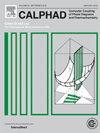Optimization of heat capacities of wurtzite phases as a single system and thermodynamic properties of nihonium nitride
IF 1.9
3区 材料科学
Q4 CHEMISTRY, PHYSICAL
Calphad-computer Coupling of Phase Diagrams and Thermochemistry
Pub Date : 2025-04-05
DOI:10.1016/j.calphad.2025.102824
引用次数: 0
Abstract
In this work, two independent methods were used to describe the heat capacity of reference compounds with the wurtzite structure, as well as their isostructural analogs of fourth group elements in the solid state: 1) a semi-empirical method using a multiparameter function and 2) a method based on the density functional theory. In the first method, to describe a set of isostructural experimental data Cp(T) of substances in the solid state, a description of each individual phase was carried out in the first approximation, and then, after finding a set of its fitting parameters (X), a description of the entire set of data as an integral system, where the set of each individual fitting parameter was described by a polynomial equation of functions included in the multiparameter family with the best description of the set of all data. The parameters of unexplored substances were found by interpolation of the multiparameter function. The fitting parameters (X) are a function of the atomic number of the elements Si, Ge, Sn, Pb, and Fl or the half-sum of the atomic numbers of the binary phases AIIIBV: B, Al, Ga, Tl, and Nh with the element germanium having a characteristic point for the set of parameters (X) depending on the atomic number. For each substance, the parameters are found by minimizing the discrepancy between the theoretical dependence Cp(T) and the corresponding experimental data. According to the fine structure constant (α = 1/137) (or Sommerfeld constant), there are no other elements in this group. Therefore, the limiting heat capacity of the wurtzite phases is at element 114 (114Fl) and has a value of Cp = 30.5 ± 0.3 J · mol-at−1 · K−1.
The second method allows us to describe the heat capacities (Cp) for these materials using a new first-principles method based on the density functional theory. This method, called the Beyond Quasi-Harmonic method, includes all anharmonic vibrations - volume changes and phonon-phonon interactions. Our calculated values for III-V compounds with wurtzite and sphalerite structures show good agreement between the two methods.
This work also presents optimized thermodynamic properties, Gibb's energy, enthalpy and entropy of formations, as well as standard entropy and melting point of III-V nitrides, including nihonium nitride.
纤锌矿相作为单一体系的热容优化及氮化镍的热力学性质
本文采用了两种独立的方法来描述具有纤锌矿结构的参比化合物及其固体中第四族元素的类似物的热容:1)使用多参数函数的半经验方法和2)基于密度泛函理论的方法。在第一种方法中,为了描述固态物质的一组同构实验数据Cp(T),首先在第一次近似中对每个单独的相进行描述,然后在找到一组其拟合参数(X)后,将整个数据集描述为一个整体系统;其中,每个单独拟合参数的集合由包含在多参数族中的函数的多项式方程描述,该函数具有对所有数据集合的最佳描述。通过多参数函数插值求出未探测物质的参数。拟合参数(X)是元素Si, Ge, Sn, Pb和Fl的原子序数的函数,或者是二元相AIIIBV: B, Al, Ga, Tl和Nh的原子序数的半和,其中元素锗根据原子序数具有参数集(X)的特征点。对于每种物质,通过最小化理论依赖Cp(T)与相应实验数据之间的差异来找到参数。根据精细结构常数(α = 1/137)(或索默菲尔德常数),该组中没有其他元素。因此,纤锌矿相的极限热容在114元素(114Fl)处,其值为Cp = 30.5±0.3 J·mol-at−1·K−1。第二种方法允许我们使用基于密度泛函理论的新的第一性原理方法来描述这些材料的热容(Cp)。这种方法被称为超准谐波方法,包括所有的非谐波振动——体积变化和声子-声子相互作用。我们对纤锌矿和闪锌矿结构的III-V化合物的计算值在两种方法之间表现出很好的一致性。本工作还提出了优化的热力学性质,吉布能量,生成焓和熵,以及III-V型氮化物的标准熵和熔点,包括氮化镍。
本文章由计算机程序翻译,如有差异,请以英文原文为准。
求助全文
约1分钟内获得全文
求助全文
来源期刊
CiteScore
4.00
自引率
16.70%
发文量
94
审稿时长
2.5 months
期刊介绍:
The design of industrial processes requires reliable thermodynamic data. CALPHAD (Computer Coupling of Phase Diagrams and Thermochemistry) aims to promote computational thermodynamics through development of models to represent thermodynamic properties for various phases which permit prediction of properties of multicomponent systems from those of binary and ternary subsystems, critical assessment of data and their incorporation into self-consistent databases, development of software to optimize and derive thermodynamic parameters and the development and use of databanks for calculations to improve understanding of various industrial and technological processes. This work is disseminated through the CALPHAD journal and its annual conference.

 求助内容:
求助内容: 应助结果提醒方式:
应助结果提醒方式:


